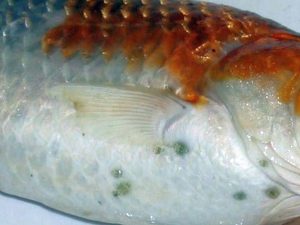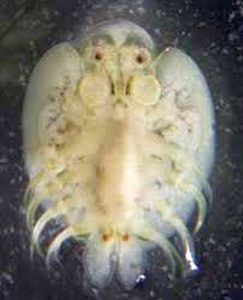The Fish Louse (Argulus spp.) is a branchiuran (crustacean like) parasite related to crabs, shrimp, and lobsters that infest and cause disease in fresh and saltwater fish.
There are over 100 different species of Argulus distributed worldwide that infest freshwater and saltwater fish species.
Argulus foliaceus, Argulus japonicus, and Argulus coregoni are commonly found in freshwater systems where they infect Koi, goldfish, and other cyprinids as well as salmonids and centrarchids.
The Fish Louse viewed from the top has an oval to round flattened body covered by a wide carapace that is approximately 3–7 mm long, and 2–4 mm wide. It has two compound eyes, and a thin needle like proboscis in front of the mouth tube that is used for piercing the host fish and sucking out it’s body fluids.
Adults have two prominent suckers that develop from hook like structures in juveniles, that are located on each side of the mouth and are used to attach to the fish. They have 4 pairs of thoracic legs with small hooks and spines to help them move around on the host fish.
Females are larger than males and can be identified by the short, paired structures at their back end called seminal receptacles, that receive sperm from the male.
Adult Argulus sp. have eye spots and round suckers on the “head” end, and spermatheca on the posterior end.
LIFE CYCLE:
Argulus spp. have a life cycle that requires a single host, and unlike the non parasitic male anchorworm (Lernaea), both sexes and all stages of Argulus are parasitic. Most Argulus have distinct male and female forms with visible testes on the males and small spermathecae on the rear of the females. After mating, which occurs on the body of the host fish, the female detaches and lays 1 to 9 strings of up to 225 gelatinous eggs in several rows on any hard substrate or vegetation in the pond or aquarium. After laying her eggs, the female returns to the host fish.
At a temperature of 95° F., the eggs hatch in about 10 days; at a temperature of 60° F, it can take as long as two months for them to hatch. The newly hatched larvae must find a host to attach themselves to quickly, and can only live on their yolk sacs for a couple of days. Juvenile Argulus propel themselves through the water column using their 4 pairs of legs and then attach to a host using the claws on their short antennae. Adult Argulus lack these claws but use a pair of suckers (maxillules) to attach. Adult fish lice can survive without a host fish for about 2 weeks.
The entire live cycle of most Argulus species on the host fish takes anywhere from 30 to 100 days, depending on water temperature.
PHYSICAL SYMPTOMS:
Fish Louse infections may be indicated by some or all of the following:
- Flashing or rubbing against hard surfaces or substrate
- Reduced or complete loss of appetite
- Erratic swimming
- Lethargic swimming
- Hanging at to surface
- Pinpoint hemorrhages
- Anemia
- Fin and scale loss
- Increased mucus production
- Poor body condition
In some cases, there may be no obvious signs of disease other than presence of the parasite. Adult and later stages of Argulus can be easily seen with the naked eye on the fish and swimming in the water column. When infected fish are removed from the water, adult Fish Louse will quickly scurry off the fish back into the water.
CAUSE:
The introduction of new fish and/or aquatic vegetation into an aquarium or pond without being properly quarantined is the main cause of Fish Louse infestations. Fish infested with juvenile Fish Lice on their skin will rapidly spread the parasite throughout an aquarium or pond if not treated.
TREATMENT:
Argulus spp. is easily treated with Microbe-Lift or DTHP.
DTHP is an organophosphate insecticide that is sold under a number of trade names like Dipterex, Dylox, D50, Masoten, Trichlorofon, Foschlor, and Neguvon. When correct dosages and application intervals are used, it is a safe, cheap, useful cure for visible external parasitic crustaceans like Fish Lice (Argulus) and Anchorworm (Lernaea) as well as some Protozoans and flukes.
- Dipterex
(Trichlorphon) is a water soluble insecticide that is often used at 98% potency to kill Argulus and Anchor Worm infestations in ponds. A 1 milliliter to 790 – 1320 gallons of water dose used three times at 7 day intervals to treat large ponds is extremely effective.
Because Dipterex breaks down after a few days, the Argulus and Anchor Worm eggs and emerging parasites that survive the initial treatment are killed by the follow up treatments, hence the 7 day interval treatments.
- Microbe-Lift
is a safer, more convenient medication that is safe for use on all ornamental pond fish, reptiles, amphibians and mollusks. It must NOT be used with crayfish and other crustaceans.
Using any of the above treatments may require follow up treatments for bacterial and fungal infections caused by damage to affected tissue from burrowing Fish Lice or Anchor Worms.
PREVENTION:
Prophylactic dipping and quarantining of new fish before introducing them into an existing system is the surest way to prevent Argulus infestations for occurring, especially with high risk species like Koi and goldfish. Visual screening for adult Argulus with extended monitoring of quarantined fish is a good alternative.
When parasites are detected, treat immediately with one of the above methods and maintain high water quality.
Sterilize the aquarium or pond completely to minimize any re infestations.




